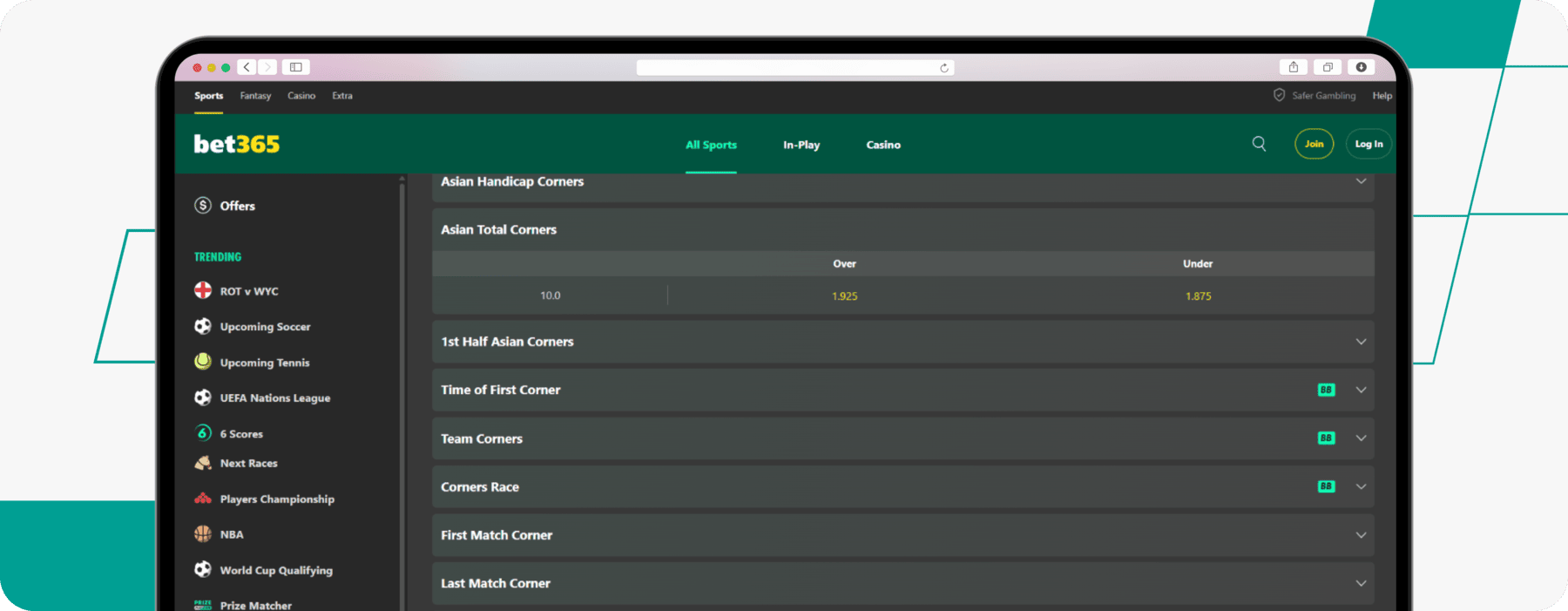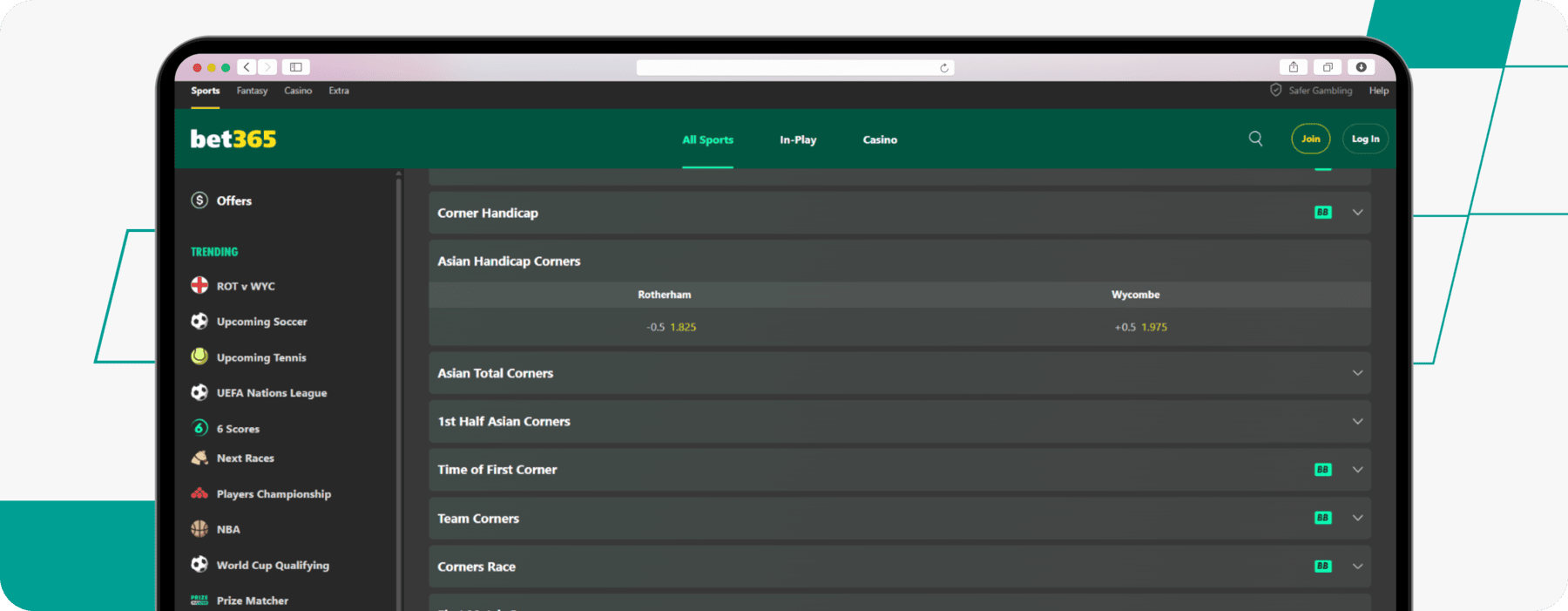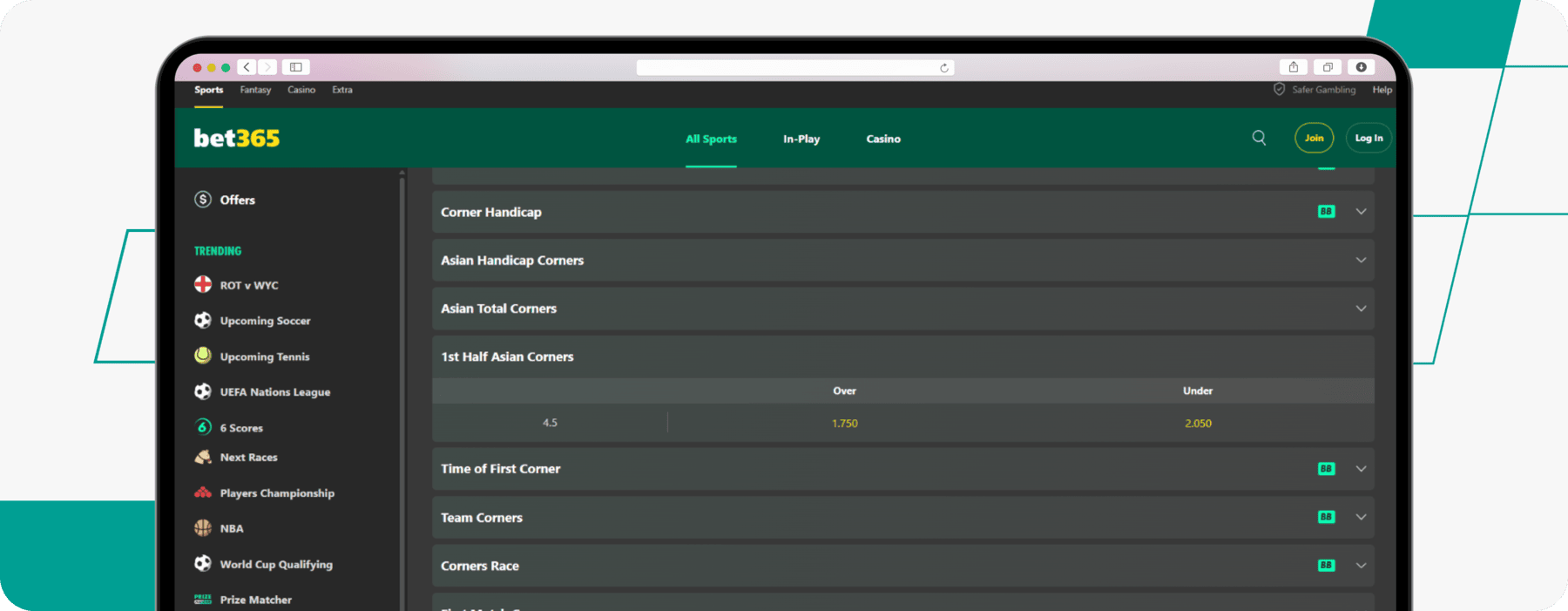Corner betting markets are booming. They’re getting unprecedented coverage on stats-based sites, including our very own KickForm. This growth has opened the doors to related bets, such as Asian corners, which is, for us, one of the betting sector's most exciting markets. Today, we’ve got the whole shebang on how it works and, most importantly, how to find value.
What Are Asian Corners?
Before we jump into what are Asian corners, we want to drop a bit of a knowledge bomb on why “Asian” is used in betting. Simply put, these markets originated in, you guessed it, Asia, and are designed to alter three into two-outcome bets. They’re used across multiple formats, including goals, cards, handicaps and, of course, Asian corners. History lesson over.
The basics are that you’re betting, in some form, on the number of corners in a match. What we get from an Asian line is a definitive result, eliminating the “exactly X corners” outcome.
The bets include whole and quarter line results, which create win, loss and push (money back if the number of corners is exact) outcomes. It’s a cool way of betting, as if you don’t win, the push creates a buffer for bets that would otherwise lose.
So, why would anyone bet on traditional corner betting markets? Well, here’s the catch. Think of the Asian corner market as mob boss Tony Soprano, and he’s offering his security services for your bet. Amazing, right? But to have Big T on board, you’ve got to pay. So, betting on Asian corners removes some of your bottom line, but eventually, the safety blanket will pay dividends in the long run.
Asian Betting Across Bookmakers
A good way to better understand how Asian corner betting works is by looking at other markets in its sphere. Pretences are the same; the three-way markets have been replaced with two-way markets to remove the exact results. Let’s take a quick look at some of the more popular variations.
This is applied to the match result. Goals are added or removed, signified by positive (goals added) or negative (goals removed) numbers. For example, Manchester United -1.5 means they must win by two or more goals for this bet to cash. The bookies generally apply handicaps between 0.5 and 3.5 goals to create odds as close to even money as possible.
Alternative markets are an extension of the traditional handicap. You can pick from an extensive range with multiple options, and the odds will reflect that. For example, if Manchester United at -1.5 was even money, the odds for -2.5 might be 5/2, and -3.5 at 6/1. The more of a handicap you give a team, the bigger the odds.
These bets are linked to the total number of goals. The bookies set a line, and you pick the over or under for that line. Again, the bookies will set the line near to even money. It’s designed to be the number that levels the playing field.
Another market extension. Choose from multiple goal lines, ranging from one up to six or even higher in some games. You still pick the over or under for that line, but the odds change depending on the likelihood of the result.
All you do for this market is choose the over/under line for the total number of cards shown in a game. It’s worth noting that yellow cards count as one and red cards as two.
Asian Corner Betting Explained
Each market will have different Asian corners meaning. There are two notables: total corners and handicap corners. We’ll talk more about these next, but first, we want to explain how outcomes can differ for each.
Asian Total Corners Betting

For Asian total corners, you’re betting on the combined number of corners for both teams. The bookies will have this as an over/under bet, setting the line as close to even money as possible.
The line will be a round number: seven, eight, nine, and so on. Obviously, with these round numbers, there’s a chance it can land on exactly that amount, and if you’ve chosen the over or under for that line, technically, you’d be wrong.
This is where the Asian total corners' meaning comes into play. If things are tied, the bet is a push, so you get your money back. Let’s run a quick example, assuming the line is eight corners, and we’ve bet on the over for an upcoming Premier League game between West Ham United and Newcastle United.
| Corners Taken | Bet Result | What Happens to Your Bet |
|---|---|---|
| 7 or fewer | Loss | This is under the line (8), so you lose the entire bet |
| Exactly 8 | Push (Draw) | You get your money back with the exact number |
| 9 or more | Win | This is over the line (8), so you win the entire bet |
So, you now know how Asian total corners work, but where do you bet? Well, the best of the best is bet365. They’ve got incredible odds and host more Asian handicap betting markets than anyone else. It’s a killer combo.
Asian Handicap Corners Betting

For Asian handicap corners, we’re betting on individual teams. It’s very similar to betting on the goals market, but instead, it’s for corners.
For example, you might see Arsenal -2 corners vs. Brighton +2 corners. If you bet on Arsenal, you’ll need them to have three or more corners than Brighton to win, and exactly two more for a push. One or less, and you lose the bet. The plus and minus numbers highlight whether corners are added or subtracted from the final score.
The bookmaker's goal for this is to even the playing field. The number of corners will be the gap that gets them as close to evens as possible. We’re going to preview the Champions League game between PSG and Liverpool as an example:
| Team | Handicap | Odds | For the Bet to Win | Needed for a Push | For the Bet to Lose |
|---|---|---|---|---|---|
| PSG | -1.0 | 1.875 | PSG has two or more corners than Liverpool | PSG has exactly one corner more than Liverpool | The same or fewer corners than Liverpool |
| Liverpool | +1.0 | 1.925 | Liverpool equal corners or more than PSG | Liverpool has exactly one less corner than PSG | Liverpool has two or more corners fewer than PSG |
The bet365 love-in continues for Asian corners, folks. But they really are at the top of the pile for all Asian markets, so it’s no surprise to see them dominating here as well. If you want some security with your first bet, check out the bet365 sign-up offer, where you can claim up to £50 in free bets from just a tenner.
1st Half Asian Corners Betting

The name is a bit of a giveaway here, but just for complete clarity, you can reduce these Asian corners bets to just the first half; hence, 1st half Asian corners meaning. It works like the totals corner betting markets, where you bet on the over/under line, and the bookies do their best to set a line where the odds are close to evens.
There’s not a lot more to these markets that differ from the 90-minute variants. We want to add that this includes added time at the end of the first half.
Frustratingly, this is not a common market. There aren’t all that many of the best online bookies that have it. But there is one. And it’s probably not all that hard to guess who… that’s right, bet365. Honestly, for any Asian markets, they’re the best. This isn’t a promo for them; it’s just a fact – and we’ve used them almost exclusively for Asian corners betting for over a decade.
How To Calculate an Asian Corner Bet
Asian betting odds. Up there with the Great Wall of China and the Taj Mahal as the world's eighth wonder. But they needn’t be, and we’ll show you how they work in the simplest form possible.
Let’s kick things off with how the odds are displayed. In the UK, we’re used to fractional odds (2/1, 7/2, 12/1, etc.), but for these bets, the bookies showcase them as decimals (2.00, 3.00, 4.50, etc.).
INFO
Ben, one of our amazing sports writers at TPP, has written a complete guide on betting odds, including a betting calculator where you can convert decimals into fractions. Thank you, Mr Gibson.
The next part for Asian corner odds is how the bet is settled. This is defined as whole, half and quarter numbers. They each have little nuances, and the easiest way for us to show you is in the form of, yet another, table:
| Type of Line | Example | How it Works |
|---|---|---|
| Whole Number | -2.0 | A win if three or more corners than the line; a push if exactly two corners from the line; a loss if one or more corners from the line. |
| Half Numbers | -4.5 | A win if five or more corners than the line; A loss if four or fewer corners less than the line. No push for half numbers, straight win or lose. |
| Quarter Numbers (low) | 9.25 | The stake is split; half on 9 corners and half on 9.5 corners. The bet then plays out on same terms as whole and half numbers for each side. |
| Quarter Numbers (high) | 9.75 | The stake is split; half on 9.5 corners and half on 10 or more corners. The bet pays out on the same terms as whole and half numbers for each side. |
| Whole and Half Numbers | 1.0, 1.5 | The stake is split; half on over 1.5 corners and half on one or more corners. Two or more corners wins both bets; one corner is a push for one and a loss for the other; zero corners lose both bets. |
Using Statistics to Wager on Asian Corners
Asian corner markets differ from regular corner betting, but the process of finding value is still the same. We’ve addressed areas to look at for the main betting markets below, but we strongly recommend you check out our stats table above. We may be slightly biased, but we’ve created one of the best tools for finding value in this market, which we use daily for our corner betting tips.
For Asian total corners, start with averages per game for both teams. This will create a baseline expectation that can be used as a reference to the betting odds. For example, in the 2024/25 season, Tottenham’s games have averaged 13.04 corners, and Brentford's have averaged 11.19. The combined average is 12.16. This is the number that should be even money. So, if we can find a bookie that is offering even money at over 10.5 corners or better, we know we’ve found value.
For Asian handicap corners, we must focus on individual teams. Let’s stick with Spurs, who, on average, take the most corners per game at 7.48 and throw Bournemouth into the mix, who take the least at 3.63. This means that Spurs take 3.85 corners per game more than Bournemouth. So, we’re looking at anything around +3/+4 on the handicap at even money. The higher the odds for this line, the better.
Asian Corners vs Regular Corner Betting
It’s just corner betting, right? Well, yes and no. There are similarities between the two in that you need to establish how many corners will be taken. But from a betting standpoint, there are differences.
Most notably, Asian corners are a two-way market, and regular corner betting is three-way. Basically, this means that with the regular market, you can bet on the exact number – an option not available for Asian markets.
You also get the added security with Asian bets, as if the result lands on an exact number, the bet will be pushed, and your stake is returned. The trade-off for this security is slightly lower odds. For example, Spurs (again) are playing AZ in the Europa League, where over 10 corners on the regular market is 11/10 and for Asian corners betting is 10/11.
Pros & Cons of Wagering on Asian Corners
All betting markets come with pros and cons, and even though Asian corners explained like this are great, they aren’t perfect.
For example, having the security of a push for tied bets is great. But the flip side is that you’re getting slightly smaller odds, which lessen the value of a bet. Let’s run through a few more reasons below:
- Stake protection means that you get your money back if the total number of corners lands on the exact number, which would otherwise be a loss.
- Allows you to bet more freely on underdogs with the safety net of a push.
- Provides more options to bet on than traditional corner markets: Totals, handicaps, first half, etc.
- Offering two-outcome markets instead of three removes an additional dynamic you otherwise would have to consider for finding value.
- Bookies aren’t always as sharp with Asian corners. Sometimes, the odds for this market are the same for traditional corners with the added push protection.
- Punters can be confused by terminology like corner handicap (-0.5) meanings and the use of split bets.
- Generally, the odds are lower because of the push safety net.
- It can take some time to wrap your head around it all, and the learning curve is steeper than a traditional corner betting market – although it's worth it!
- Limited availability, and not all bookies cover these markets.
ThePuntersPage Final Say
We’re big fans of Asian betting markets in general, so combining this with corner betting has been a revelation. It may seem a little alien if you're new, but stick with it, as there’s so much value to be had across the board. Use our guide as your cornerstone (pun intended) and apply the theory and strategies we’ve devised to maximise those sweet, sweet profits.
Asian Corner Betting FAQs
An Asian corner bet is a two-outcome market, meaning there are only win or lose results. For example, the bookmaker might set a line of over/under 10.5 corners, and you pick from those two options.
Handicaps are head-to-head bets. Each team has a handicap applied of either a positive or negative number of corners, and your bet needs to cover that to win. For example, if you bet on Chelsea at +2 corners, for the bet to win, they need to take three or more than their opponent. If the number is exactly two more, the bet is a push and one more or less, the bet losses.
Bet365 is a standout for Asian corner betting. They have more markets and are included in more games than any other. They cover Asian totals, handicaps and first-half corners.
Asian corners allow you to bet on two-way markets, as opposed to three-way markets for corner betting. They can include whole, half and quarter numbers to signify differences in how the bet pays out.
This depends on the market. For handicap markets, you bet head-to-head with two teams, choosing a positive or negative theoretical corner advantage. For a totals bet, you’re betting on the over/under line for the combined number of corners in the match.
Yes, most bookmakers allow you to use free bets on Asian corner markets. However, we always advise checking the T&Cs for market limitations before signing up. If you’re still not sure, customer support will advise you.


